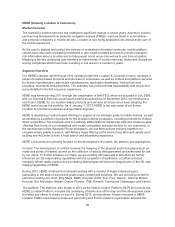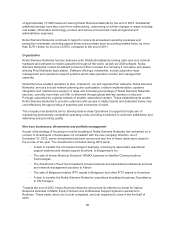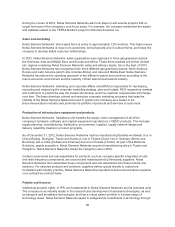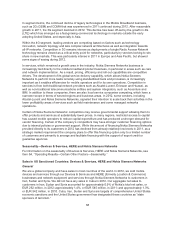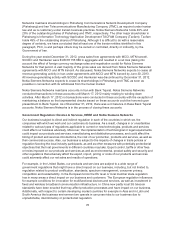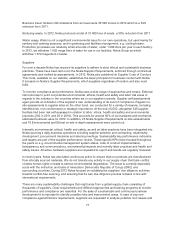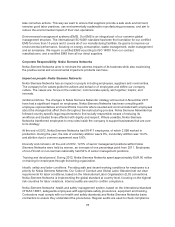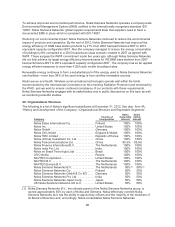Nokia 2012 Annual Report Download - page 71
Download and view the complete annual report
Please find page 71 of the 2012 Nokia annual report below. You can navigate through the pages in the report by either clicking on the pages listed below, or by using the keyword search tool below to find specific information within the annual report.Networks maintains shareholdings in Pishahang Communications Network Development Company
(Pishahang) and Iran Telecommunications Manufacturing Company (ITMC), as required under Iranian
law and as is customary under Iranian business practices. Nokia Siemens Networks holds 49% and
20% of the outstanding shares of Pishahang and ITMC, respectively. The other major shareholder in
Pishahang is Information Technology Application Development TACFAM Company (Tacfam). Tacfam
holds 49% of the outstanding shares of Pishahang. Although it is difficult to do with a reasonable
degree of certainty, we have concluded that at least one of the lranian entities identified in this
paragraph, PCC, is and perhaps others may be owned or controlled, directly or indirectly, by the
Government of Iran.
During the year ended December 31, 2012, gross sales from agreements with MCCI, MTN Irancell,
SCCDC and Hamkaran were EUR 68 156 689 in aggregate and resulted in a net loss (taking into
account the effect of foreign currency exchange rates and repatriation costs) for Nokia Siemens
Networks for that period. A vast majority of the gross sales are derived from Nokia Siemens Networks’
agreements with MCCI and MTN Irancell. As discussed, Nokia Siemens Networks expects to cease all
revenue-generating activity in Iran under agreements with MCCI and MTN Irancell by June 30, 2013.
All revenue-generating activity with SCCDC and Hamkaran was discontinued by December 31, 2012.
Nokia Siemens Networks expects to cease its shareholdings in Pishahang and ITMC as soon as
possible in connection with its withdrawal from the Iranian market.
Nokia Siemens Networks maintains accounts in Iran with Bank Tejarat. Nokia Siemens Networks
conducted transactions in these accounts until March 17, 2012 mainly relating to winding down
activities. After March 17, 2012 no transactions were conducted in these accounts with the exception of
maintaining a balance so that unpresented checks issued on these accounts could be honored upon
presentment to Bank Tejerat. As of December 31, 2012, there was a nil balance in these Bank Tejarat
accounts. Nokia Siemens Networks is in the process of closing these accounts.
Government Regulation: Devices & Services, HERE and Nokia Siemens Networks
Our business is subject to direct and indirect regulation in each of the countries in which we, the
companies with which we work and our customers do business. As a result, changes in or uncertainties
related to various types of regulations applicable to current or new technologies, products and services
could affect our business adversely. Moreover, the implementation of technological or legal requirements
could impact our products and services, manufacturing and distribution processes, and could affect the
timing of product and services introductions, the cost of our production, products and services, as well as
their commercial success. Also, our business is subject to the impacts of changes in trade policies or
regulation favoring the local industry participants, as well as other measures with potentially protectionist
objectives that the host governments in different countries may take. Export control, tariffs or other fees
or levies imposed on our products and services as well as environmental, product safety and security and
other regulations that adversely affect the export, import, pricing or costs of our products and services
could adversely affect our net sales and results of operations.
For example, in the United States, our products and services are subject to a wide range of
government regulations that might have a direct impact on our business, including, but not limited to,
regulation related to product certification, standards, spectrum management, consumer privacy,
competition and sustainability. In the European Union the EU level or local member state regulation
has in many areas a direct impact on our business and customers. The European regulation influences
for example conditions for innovation for multifunctional devices and services, as well as investment in
fixed and wireless broadband communication infrastructure. In China new partly local 3G telecom
standards have been enacted that may affect production processes and have impact on our business.
Additionally, with respect to certain developing market countries for example in Asia and in Latin and
South America the business environment we operate in can pose risks to our business due to
unpredictable, discriminatory or protectionist regulation.
70


